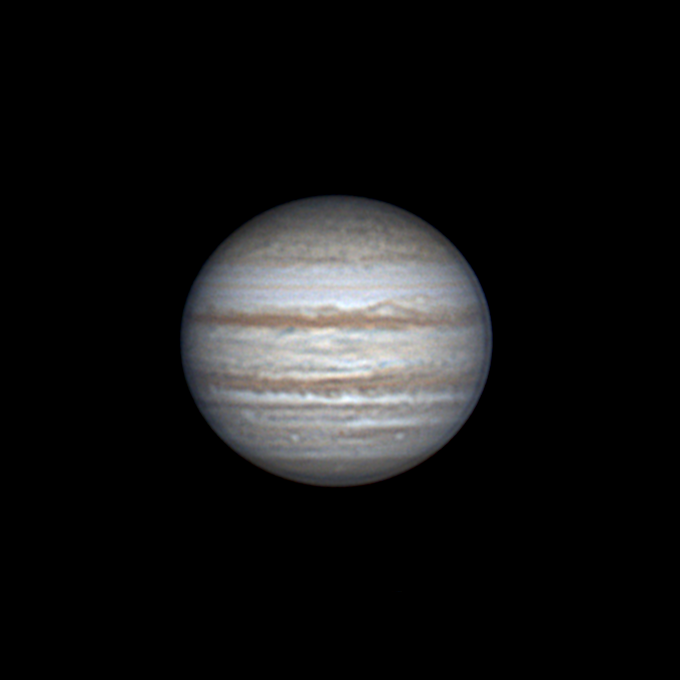Amateur Astrophotography
Skywatcher Skymax Maksutov-Cassegrain f = 1500mm / D=127mm F12 SynScan AZ GOTO
Skywatcher Skyhawk Newtonian f= 500mm (450mm) / D=114mm F4
Skywatcher Explorer 130PDS Newtonian, f=650mm / D=130mm F5 with Skywatcher Mount EQ5 Pro SynScan GoTo
2020
Using the Skywatcher Mak 127/1500, the stock 2X Barlow and the camera RisingTech G3M290 it is possible to get unbelievable pictures of the planets. The pictures are obtained by processing avi videos. The free software used for processing: Autostakkert 3 (to get stacked image), Registax 6 (wavelets), and GIMP (final processing). The images are a bit on the over-processed side, but I did care a bit more about trying to get as much detail as possible rather than absolutely beautiful. Anyway, to me, taking into account the size of the telescope, the images that follow are incredible. You will see images quite close to the resolution limit of the telescope. Taking into account my short experience (1 month) using the equipment, and the fact that Jupiter and Saturn were getting lower, I feel very proud. Because of that so you will see them getting worser. Sorry! Anyway, they are still informative about the planets.
It is possible to get better images when the planets are a bit higher from the horizon, using a devices like the "Barlow ZWO ADC Atmospheric Dispersion Corrector" and processing stacked images by means of Fitswork (deconvolution) and WINJUPOS (derotation). So many things to learn!
September 11th at 21h 32min UTC. We can see a wonderful image of Jupiter with its red spot right in the middle. On the upper left side we can see the satellite Europa beginning its transit.

September 13th at 21h 14min UTC. We can see another wonderful image of Jupiter with its red spot appearing from the left side. We can see the sharp shadow of Callisto over Jupiter
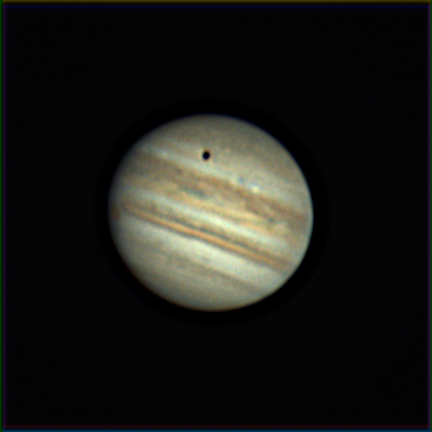
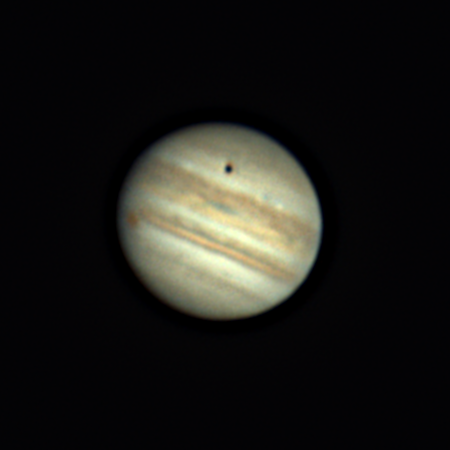
In this animated gif we can see the evolution of 50 minuts of Callisto's shadow over Jupiter and the red spot from the left side.
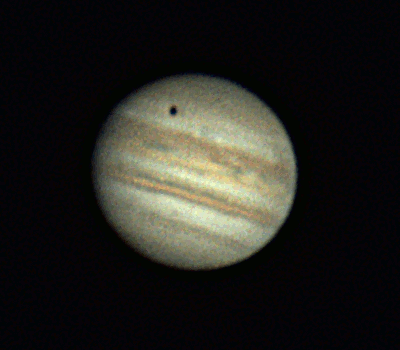
September 21 at 20h 52min. I used here a 2X Celestron X-Cel Barlow. No better results but the comparison is not at all fair because Jupiter is lower. Anyway, this is a wonderful image. Please notice the small size of the white spots in the south region of the planet.
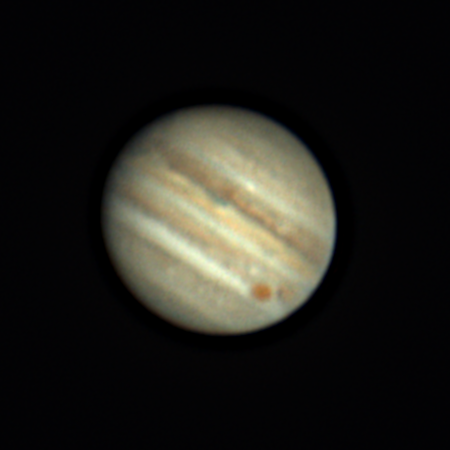
Some half an hour later the planet was looking like this:
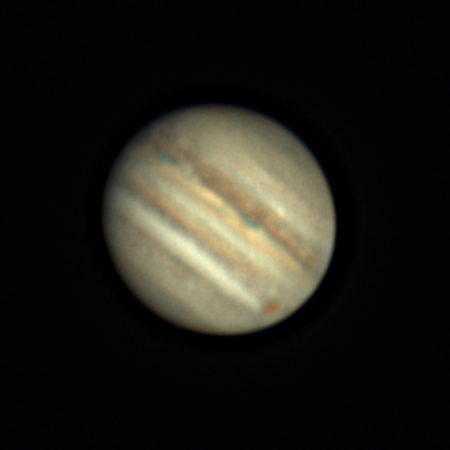
To finish the show, an animated gif follows:
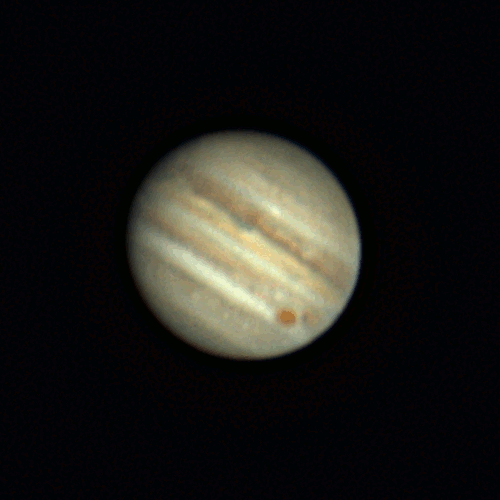
September 22 at 20h 52min. Taking the red spot as reference, we are clearly watching the other side of the planet. If you check the differences on the white band of clouds on the left and right side of the red spot (September 11), you may realize that those differences meet about the middle of this picture. Yes! The red spot is right behind us!
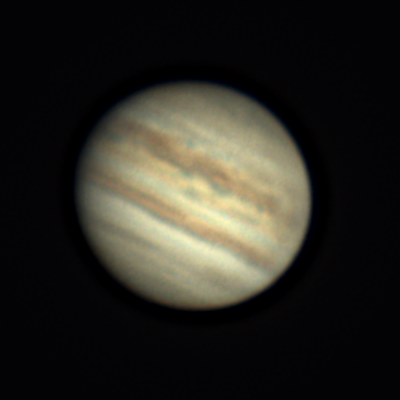
45 minutes later we get this wonderful image. In this picture we can see better the structures in the brown belt of clouds on the upper side of the planet. Beautiful!:
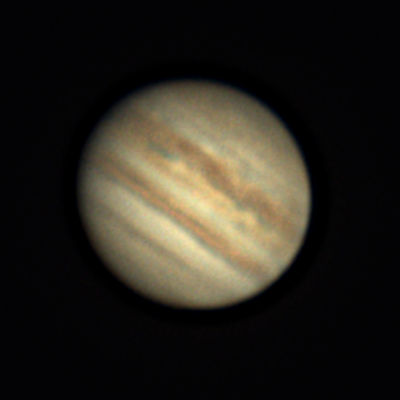
You can see now the evolution of 48 minuts of Jupiter in an animated gif:
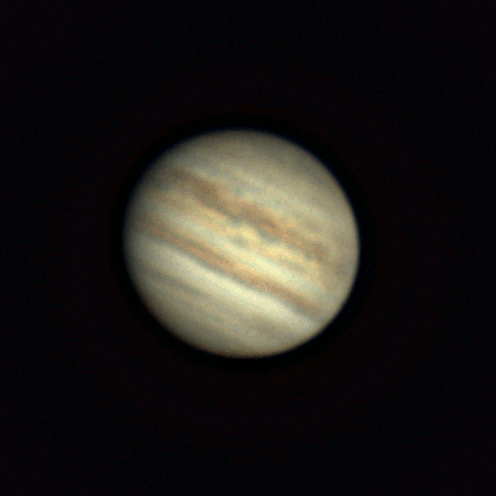
Notice that we have pictures showing the red spot in the midle of the planet, in the left most and right most region of the planet, and also in the opposite side. This means that we have information about 360º of Jupiter's atmosphere. Eureka! We got Jupiter!
One important lesson here. Even if the seeing is not so good, do not refrain yourself from taking images! The satisfaction of finding things out about the planet, all by yourself, may be as enjoyable as getting beautiful pictures.
2022
July 10th. We won't have Jupiter at opposition until September 26th. But right now it is already beginning to have a considerable size. In addition, at 5-6 in the morning it is quite high on the horizon, at about 45º, which makes it easy to obtain good quality images. On September 26 the Earth-Jupiter distance will be the shortest in 70 years and won't be this close again for another 20 years, so I decided it was a good time to start warming up engines.
This season I will be using the Skywatcher Maksutov 127/1500 F12 telescope, my new Skywatcher Eq5 pro synscan goto mount, and the RisingTech G3M385 planetary camera, with Sony IMX385 sensor, UV/IR filter and Celestron 2X X-Cel LX Barlow.
The software used to process the images: Autostakkert, Fitswork, Registax, GIMP and FFmpeg.
This is the best picture from July 10th, Jupiter and Io:
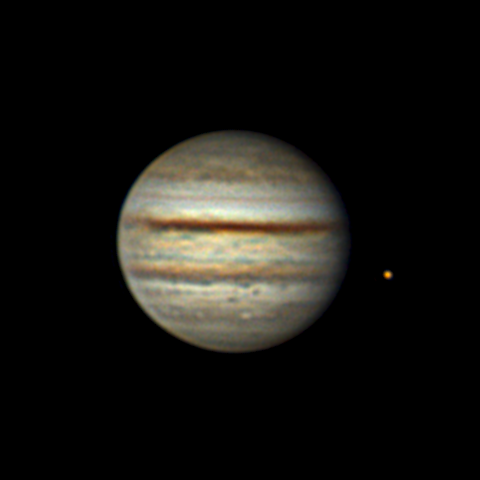
Observation took place from 4:24 am to 5:33 am. This video contains every picture:
This is the best picture from July 13th
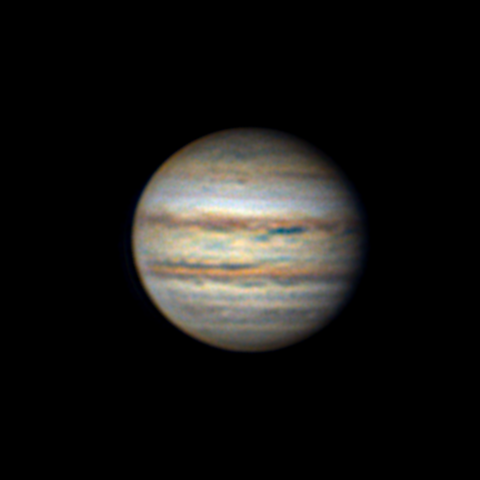
This is the best picture from July 14th. We can see the Red Spot, so beautiful!
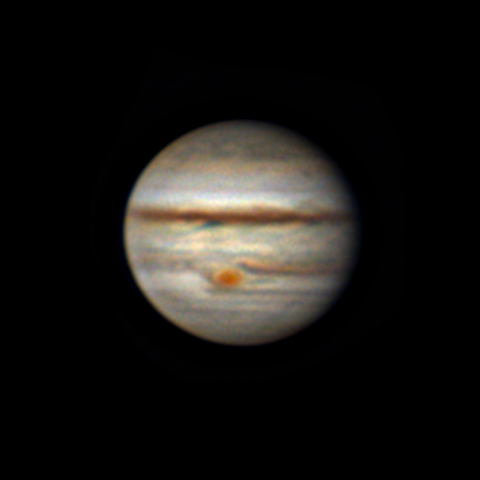
Observation took place from 4:46am to 5:46 am. This video contains every picture:
This is the best picture from July 16th. We can see the Red Spot on the left side.
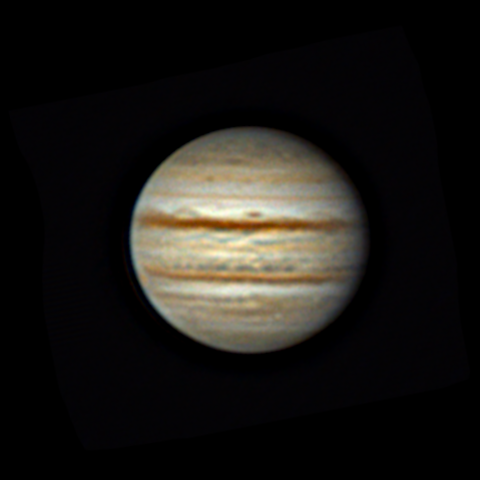
Observation took place from 4:22am to 5:44 am. This video contains every picture:
This is the best picture from July 19th. We can see the Red Spot again, but with better resolution. Jupiter is getting high and day after day the quality of the images improve.
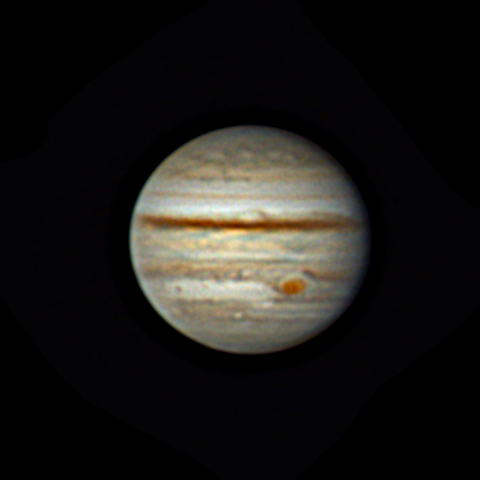
Observation took place from 3:48am to 5:52 am. This video contains every picture:
This is the best picture from July 22th. Incredible resolution.
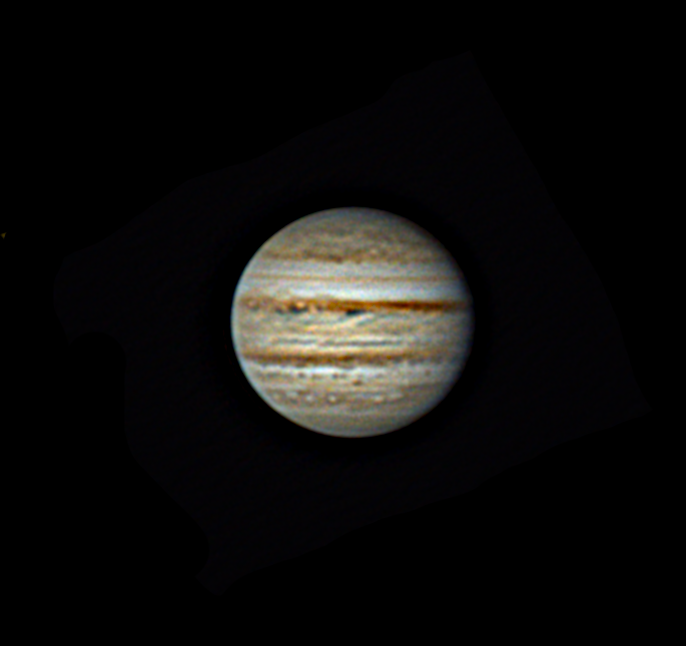
Observation took place from 3:54am to 5:46am. This video contains every picture:
Those are the best pictures from August 1st.
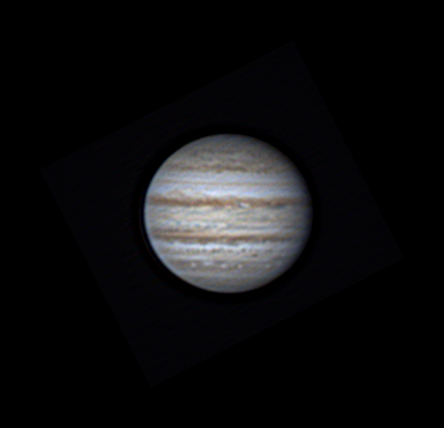

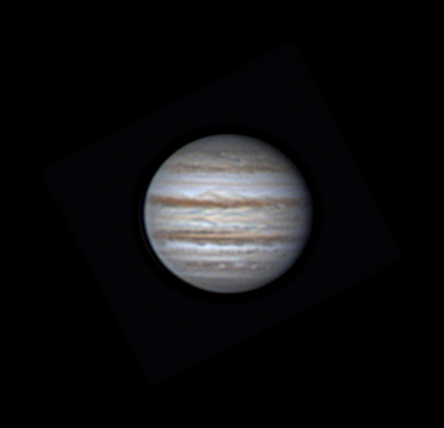

Two hours and 40 minutes of Jupiter. This video contains every picture:
Those are the best pictures from August 3rd.
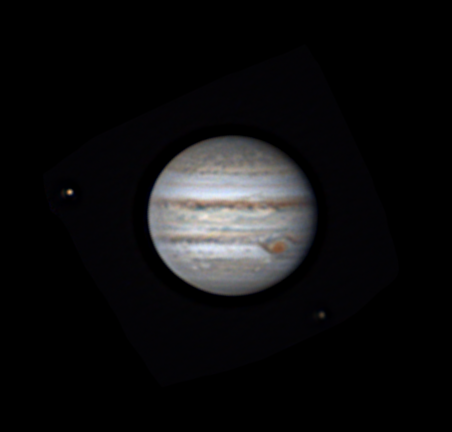
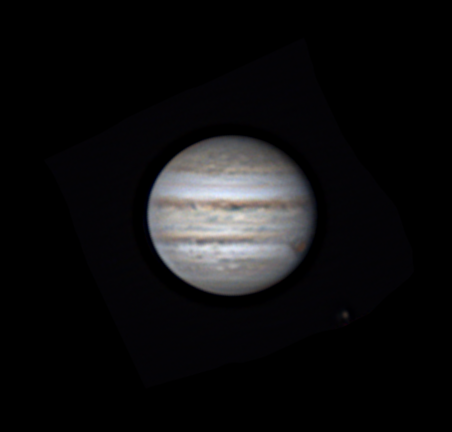
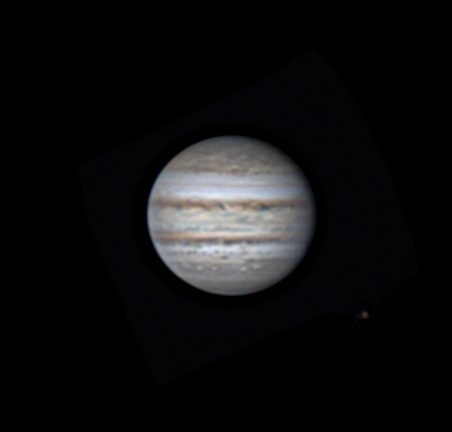
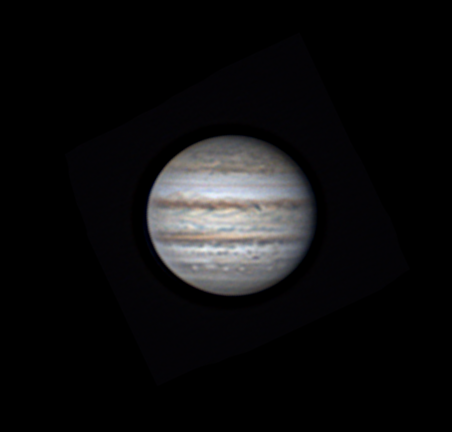
Two hours and 40 minutes of Jupiter. This video contains every picture:
Jupiter is emotion, change and evolution. Jupiter's clouds change their shape and form structures of different colors that evolve over time. It is a spectacle of planetary dimensions. And let's not say when its satellites also do their thing and walk in front of the giant as if nothing had happened. Don't miss out, the best is yet to come. There is less than a month and a half left before it goes into opposition, so we will still see it bigger and brighter. Here are four photos of the transit of Europa's shadow over Jupiter. Quadruple ration so as not to stay hungry. Bon Appetite! From day 6/08/2022.
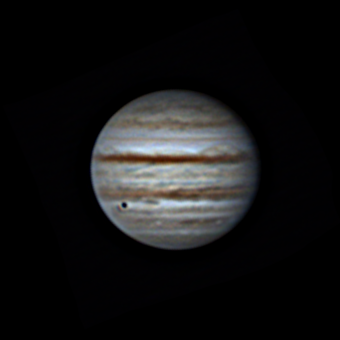
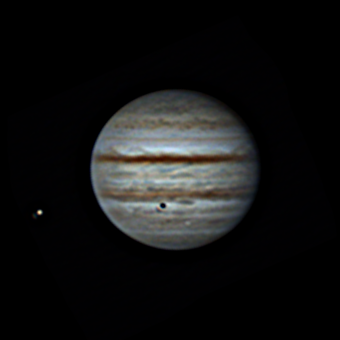
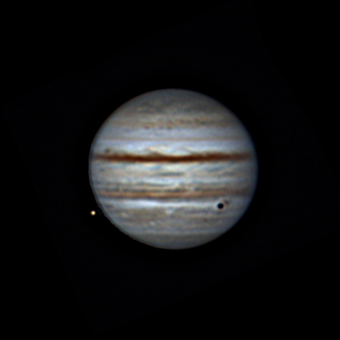
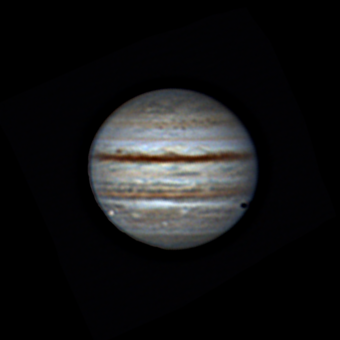
August 6. Europa, the smallest of the Galilean satellites, covered with frozen water and slightly smaller than our Moon, dared to cast its shadow for almost three hours on the surface of the great Jupiter. And he knew how to do it well, because the shadow crossed a white band of clouds, so that everyone could see it well. See this video resulting from the observation of 2 hours and 44 minutes. Observe how Europa's shadow evolves on Jupiter and how Europa appears after a while on the right side. It is interesting to imagine where the Sun was in relation to Jupiter and its satellite. The last images are slightly distorted due to a small problem with the camera control program. Pity.
Two hours and 44 minutes of Jupiter. This video contains every picture:
August 9. After having seen the transit of Europe, it was now time to see the immense Ganymede do its job. It is the largest natural satellite in the solar system, and its huge shadow over Jupiter leaves no room for doubt. But this time he was not alone; Io, the closest satellite to Jupiter, happily accompanied him creating a great event: a double transit over the gas giant. I had to fight intensely against groups of clouds that wanted to enjoy the spectacle in the front line, but such is life. They undoubtedly affected the quality of the images obtained. Four and a half hours of observation and 250GB of processed data to obtain the following set of pictures and a modest video. Enjoy it!
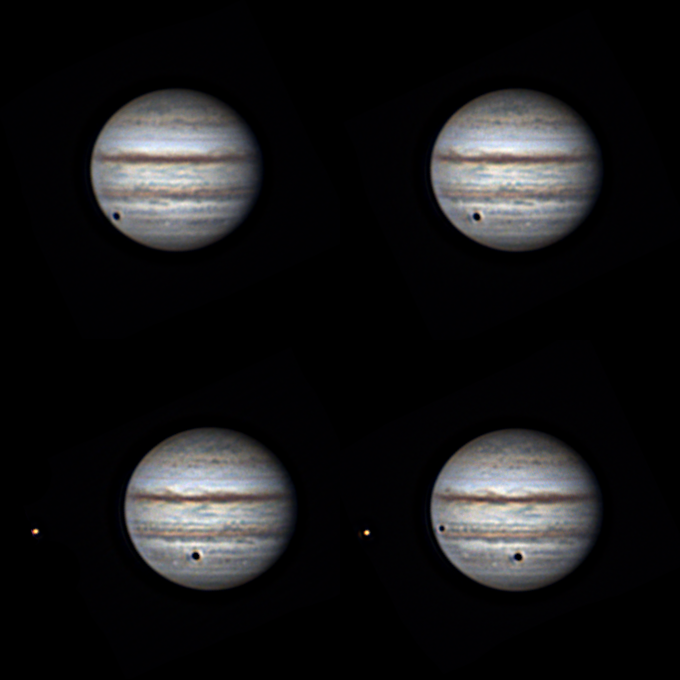

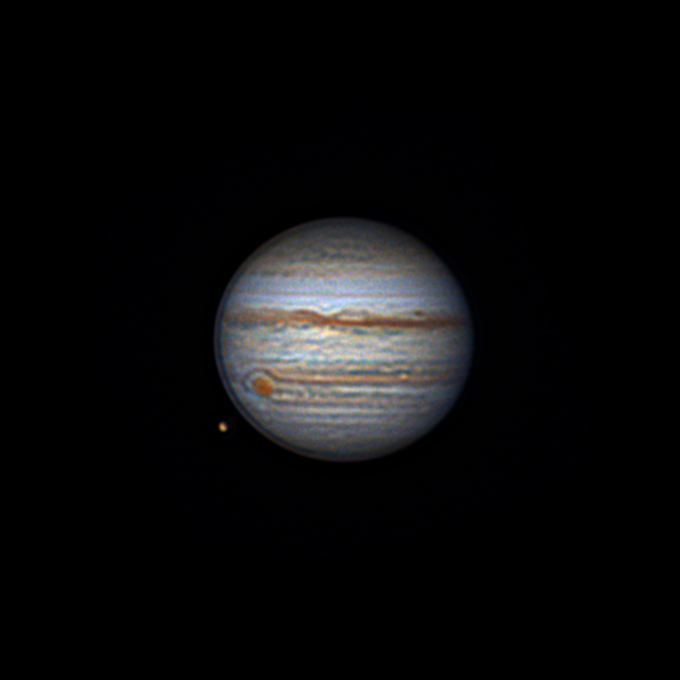
August 12. Bad seeing night. Only one picture look sort of nice. Jupiter with the Great Red Spot.
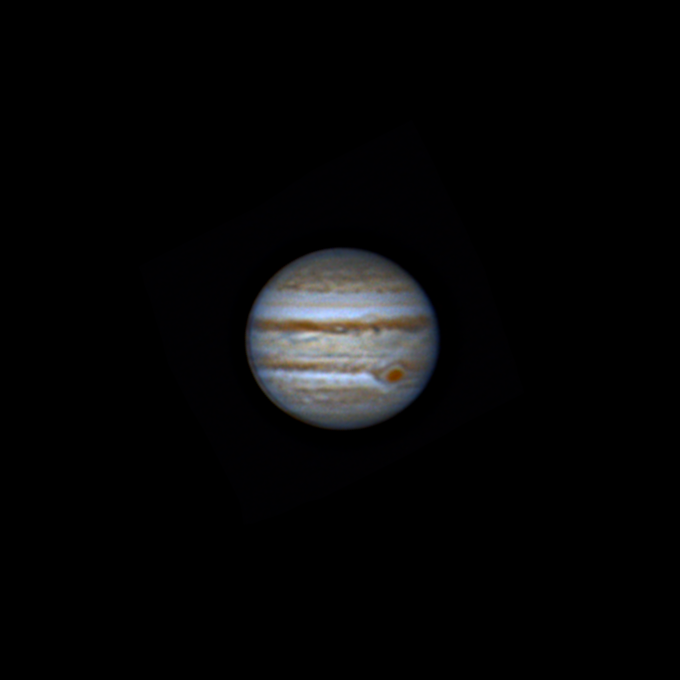
Session on August 13. Cloudless sky and full moon, but with consistent mist. From Jupiter came between 20% - 40% less light. Still the visibility was quite good at times. I had just collimated my friend Mak (how stressful!), so I started to take a few photos to stay comfortable. The two best ones:.
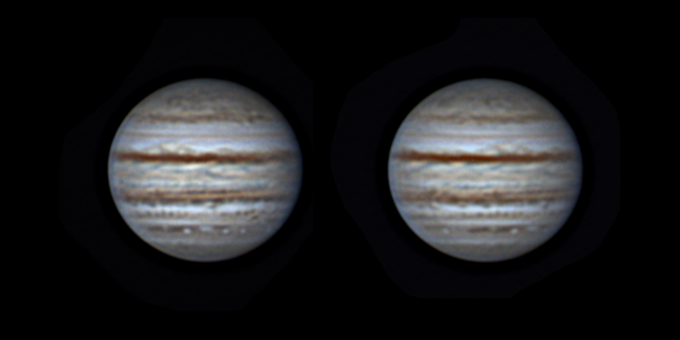
The session in a movie:
Sometimes it happens. After three consecutive heat waves, a measly 15 millimeters of rain cleanses the air. And then the northwest wind (mistral), drags all traces of moisture to the sea. The result is a clear, clean and transparent sky. Not even the Moon manages to illuminate the sky. And when that happens, the images you get are the best by far.
Early morning of August 20, "perfect" sky. Sequence of images taken at an interval of four hours. They are the best of the year and will probably be hard to beat. Note the dizzying speed of Jupiter's rotation and the level of detail in its atmosphere, and the appearance of Ganymede after hiding prior to the session.
The best images of the session of August 20. The satellite that appears is the great Ganymede. My best photos of Jupiter this year without a doubt.
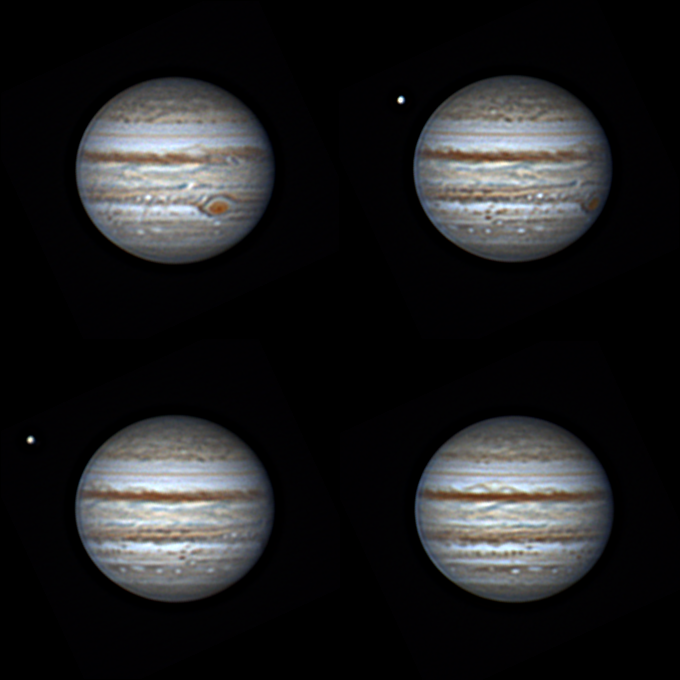
And before going to bed, a photo of Jupiter accompanied by the great Ganymede, taken during the early hours of August 20 Blessings and good night.

Early morning of August 24, 2022. There is humidity in the air and on the surface, but the visibility from 30-35º above the horizon is surprisingly good. The haze and all the dirt that had been present in the air for weeks seems to have finally disappeared. It's 4:40 and Jupiter is 50º high. On the computer screen I see details of the atmosphere that I normally only see after processing. I record several videos at about 180 images per second, with the gain at maximum and with an exposure time that exceeds 4ms. The result is the most detailed series of images I've ever gotten of Jupiter. These days everything seems to be going smoothly, and Jupiter still has a full month to go before it goes into opposition.
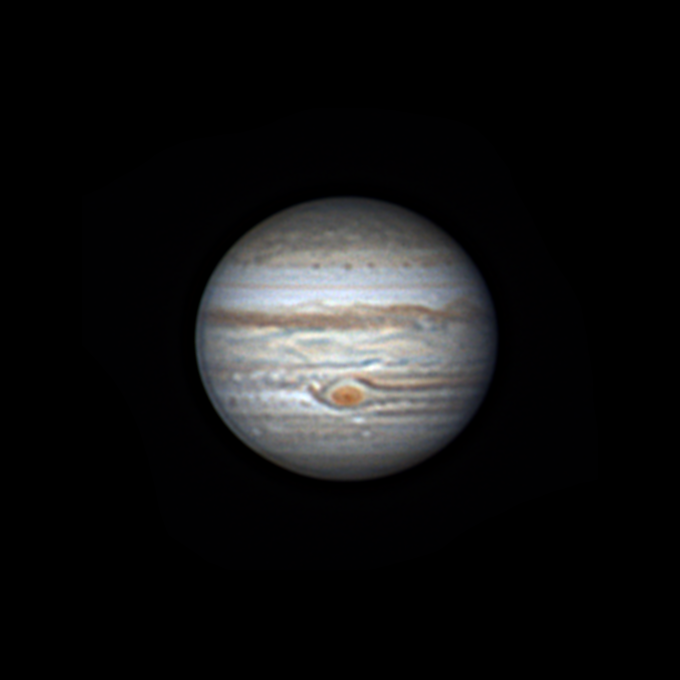
Jupiter cake. Gives for nine servings, although if you are generous and share they can be more. Made with a lot of love and a lot of dedication on the morning of August 24. I hope you enjoy it in good company and in good health.

Oh Jupiter! Why do you spin so fast? So I can see you all in one night? Bringing out the colors of Jupiter is fun and exciting: reds, oranges, browns, greens, blues, whites, greys... There is no greater spectacle on a planetary level. And besides, all those structures and bands of clouds are always changing, which ensures the pleasure of continuous discovery. The surroundings of the red spot and the cloud bands close to it are a good example. Or that prominent band of brown clouds located in the northern equatorial part, which is getting more and more jumbled every day and mixed with those strange blue-green structures, which seem to have been painted by a great artist. Jupiter is pure art, for there is no greater artist than Mother Nature. Enjoy the transit of the red spot of Jupiter. The quality of the images improves at the beginning and worsens at the end, that's life... The satellite that is observed is Europa, which shortly before had completed its transit over Jupiter.
Jupiter on the morning of August 29. 5 hours and a quarter of quiet observation. Very humid air with a certain amount of mist, but with visibility that was surprisingly good at times. See the planet turn around, which allows you to see it practically whole. Enjoy and be happy.
Jupiter cake! As always, nine portions made with a lot of love and dedication, selecting the best ingredients, this time at dawn on August 29.
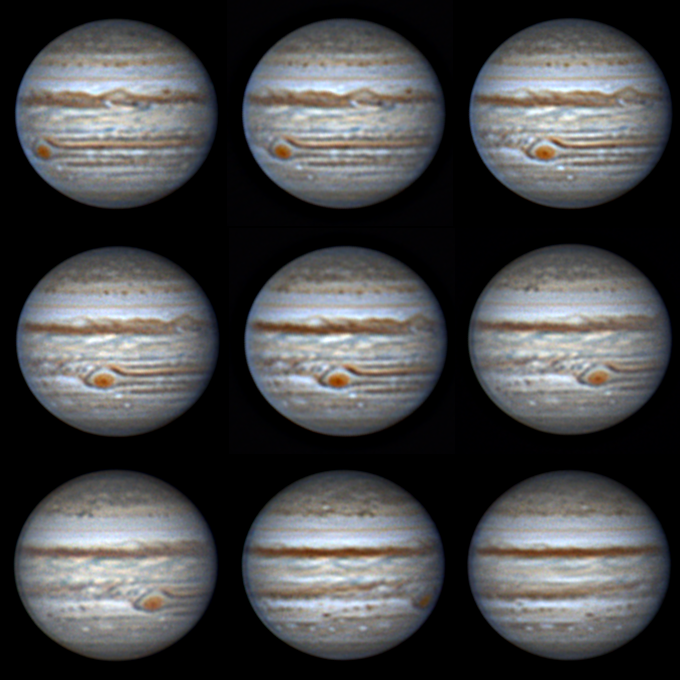
The four best images of Jupiter obtained at dawn on August 29. Reprocessed with AS!3 with the "drizzle 1.5x" option.

Transit of Io over Jupiter. Do not miss it! Io, the closest of the Galilean family, passing in front of the giant as if nothing had happened, and projecting a shadow that looks more like a deep black hole. Unique show that occurred on the morning of September 1.
Jupiter cake to the transit of Io. This time only 7 servings. But as always, made with a lot of love and dedication, selecting the best ingredients obtained during the early hours of September 1. Enjoy it in good company and in good health.
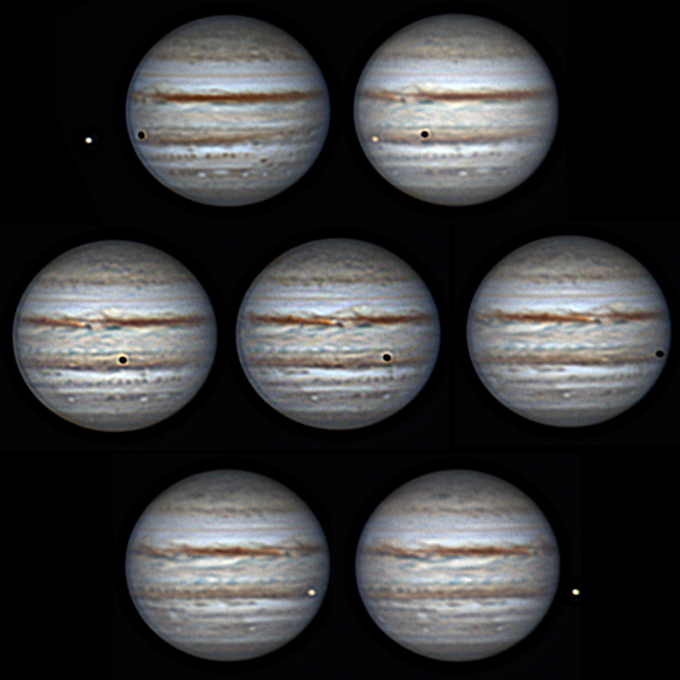
Jupiter shows his face, all faces. In a world first, I show you the full face of the gas giant. There is no corner that has not been exposed for you to enjoy in its entirety. The definitive jupiterine cake, in 7 delicious and exclusive portions. Images from two different sessions have been used (it could not be otherwise). They correspond to August 29 (the first three) and September 1 (the rest). In those of September 1, the transit of Io is observed. Between photo and photo there is an interval of about 45º (more or less). Between the last and the first there is an interval of approximately 90º. The inconsistencies between the photos are due to the differential rotation of the planet Jupiter. In an interval of 3 days differences are already noticeable.
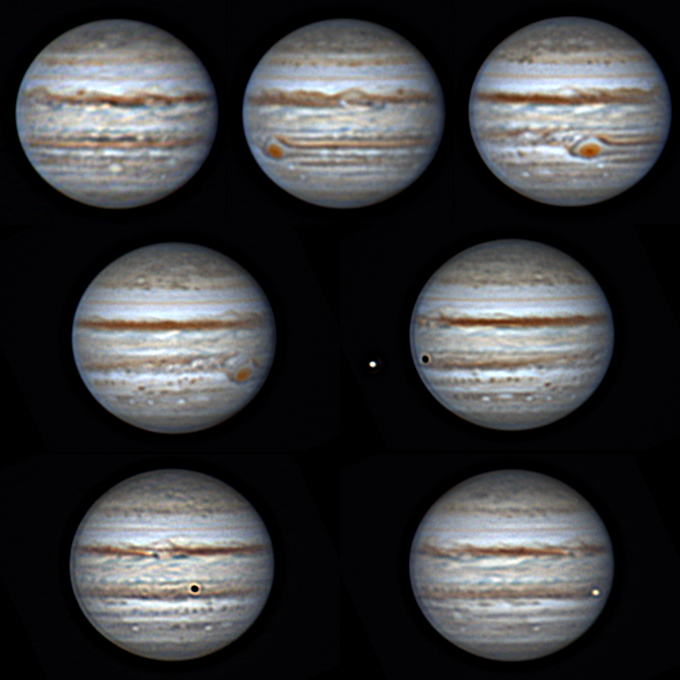
Jupiter is emotion, change and evolution. See how after more than 30 days, the images of Jupiter that are so difficult to obtain expire without remedy due to the differential rotation of the planet and the interaction of the adjoining cloud bands, among many other reasons. In particular, it is interesting to look at the surroundings of the red spot and the adjoining cloud bands. Enjoy this 6-serving cake (every day there are fewer...) before it expires (in less than 30 days!).

Image of the wonderful Jupiter, the largest planet in our Solar System, with its red spot and its bands of clouds in constant and incessant evolution. Obtained on the morning of September 1.
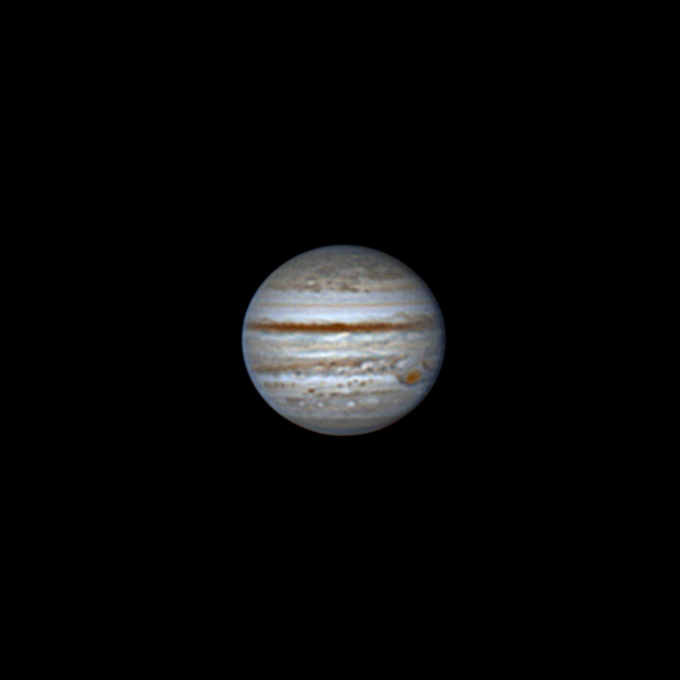
Early morning of September 7. It started well, but the turbulence in the upper layers of the atmosphere gained ground and after 3 in the morning the visibility was already very bad. Sometimes happens. There wasn't even a cloud. On the surface the air was almost static, which caused the humidity to be almost 100% (everything ended up wet!). But up there there was a lot of movement. So enjoy this modest video, a summary of two hours of observation that allows you to see a good number of details of the always beautiful and imposing Jupiter.
Clearly, Jupiter is entering opposition. The full face is already visible and the shading on the "right" side is minimal. It's not going to grow much bigger, but anyway, how huge it is! Now it is over 47.7" and will reach 48.77" on the 26th of this month. I show you the best image of this morning. But what complexity shows this planet!
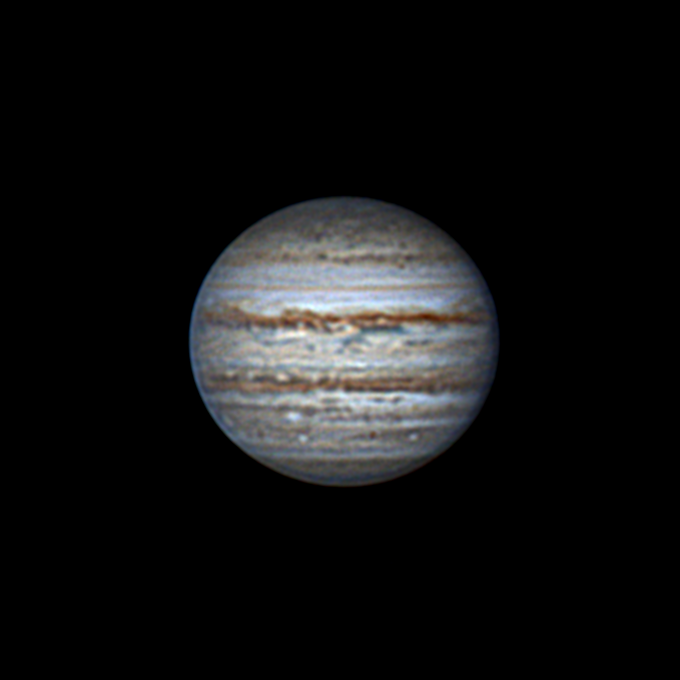
"Testimonial" image of the transit of the small Io over the great Jupiter obtained in the early hours of today, September 10. There were many clouds and air currents in height that made the session impossible. Still, it's always impressive to see that round shadow piercing Jupiter's atmosphere.
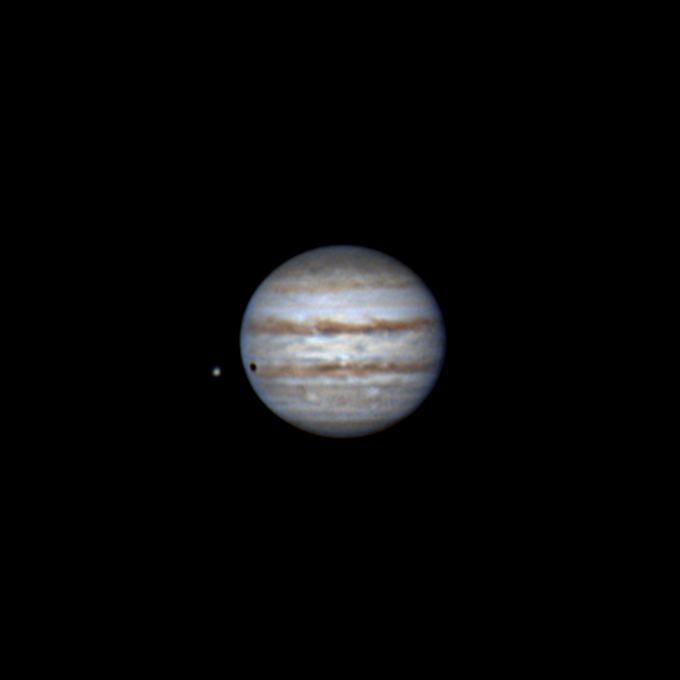
Jupiter! From today's morning (09/15) only the first image (12:07) is saved. The next minute a high air current appeared that caused tremendous turbulence and there was nothing to do. From one moment to another. Incredible. And it's the second time... This is the end of summer here.
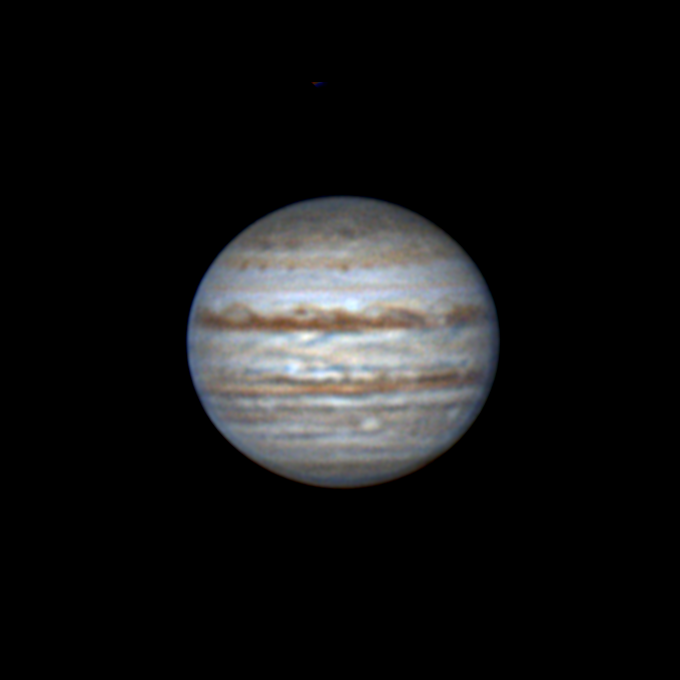
Look! This really is a black hole! You don't play games with Ganymede... Yesterday, the great Ganymede, the largest satellite in the solar system, asserted its size against Jupiter. What a hole it made in the gas giant for several hours. There was no mercy or compassion. Too bad the weather conditions weren't too good, although there were moments of better visibility that I was happy to take advantage of. Enjoy that little picture, taken at 2:41 in the morning, September 21, very sleepy and with a fairly cold breeze.
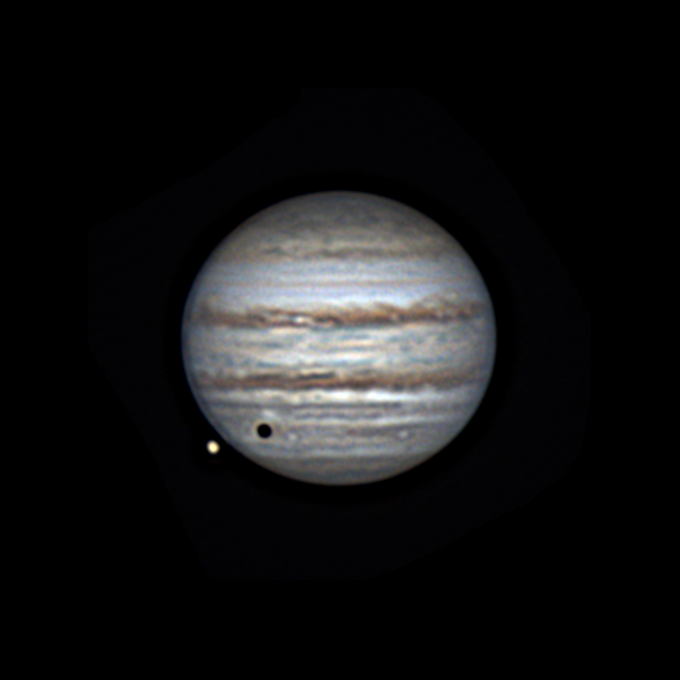
It was necessary to take advantage of the only night without clouds and without strong wind after seven long days of rigorous abstinence. In addition, the forecast for the next few days was dire. And we are already very close to the opposition, so I went for Jupiter. Video-summary of the long night of September 21-22. 5 and a half hours of observation summed up in a few seconds. At first, with Jupiter on the rise, the quality got worse instead of better, and I almost gave up. I went to eat a good ham sandwich with tomato bread, and when I returned, relaxed and satisfied, things had improved enough to continue. It got better but with fluctuations, and got worse again as Jupiter channeled the descent. The entire transit of Ganymede's shadow is observed, and almost the entire transit of the satellite itself, although it seems to me that later I will upload a separate video.
Ganymede transit over Jupiter on September 21. Come and see how Ganymede approaches Jupiter and projects his huge and forceful shadow on him. Ganymede appears very bright at first, but as it hovers over the planet, it loses that brightness until it becomes a small, dark speck. As he approaches the limbo of the planet on the other side, he begins to brighten, and just as he reaches limbo the video ends. Why? When Ganymede approaches Jupiter it appears very bright because Ganymede is on a black background (and the processing also helps exaggerate such strong contrasts somewhat). When Ganymede hovers over the planet, because Jupiter is so much brighter than Ganymede, Ganymede appears as a sad, dark smudge. Interesting, right?
Jupiter cake to Ganymede transit. This time nine huge and delicious portions! So big they hardly fit. It is amazing how far Jupiter has grown (there is very little left to be in opposition). As always, made with a lot of love and dedication, selecting the best ingredients obtained during the night of September 20 and 21. Enjoy it in good company and in good health.
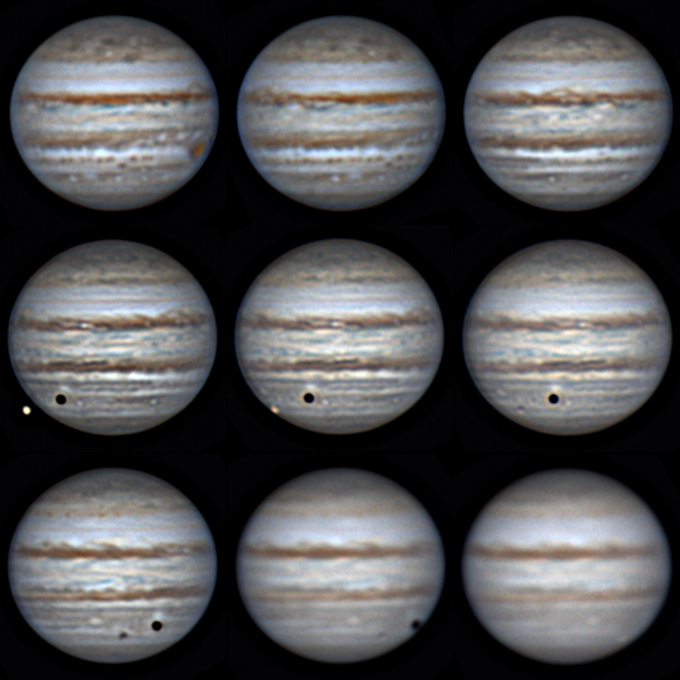
The three best images of a total of 81, obtained during the night of September 20 to 21, in which the transit of Ganymede took place. Each image has been obtained by stacking about 20,000 images (from videos of 110 seconds duration and containing about 185 images per second). The stacking is done by Autostakkert, later enhancing with Registax (wavelets) and giving the final touch with GIMP. As seen in the images, Ganymede appears as a bright spot as it approaches Jupiter, but later appears as a dark spot as it hovers over the planet.
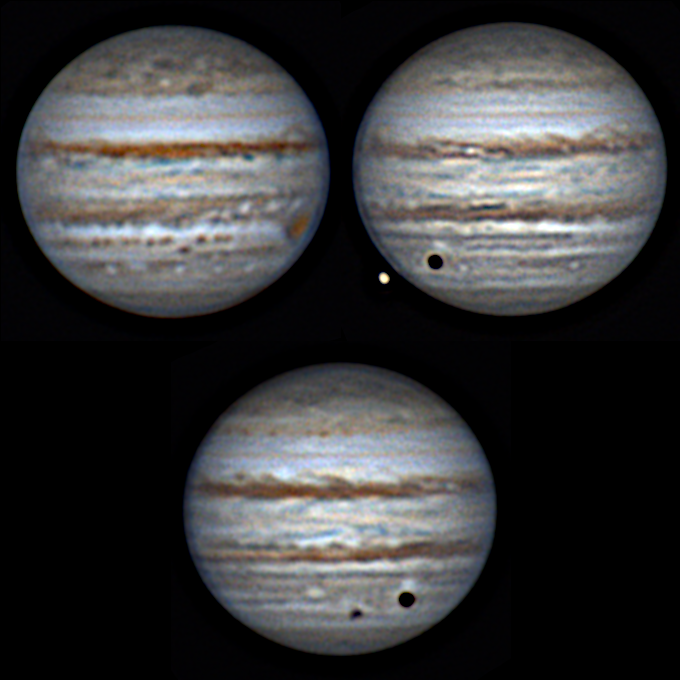
Jupiter hours before opposition, on September 25 at 10:14 at night with clouds and disastrous visibility. But I was excited to have at least one image, since the forecast was already bad weather for many days. Jupiter is accompanied by little Io.
I had fun doing a little calculation to pass the time. In the image Jupiter has a size of 210 pixels. That means that the image that the telescope gives on the camera sensor has a size of 3.75 microns x 210 = 0.787 mm. The size of the image of Jupiter is less than a millimeter!
I use the telescope with a 2x Barlow, but that factor of 2 is never exact, and if the camera is slightly separated from the Barlow lenses, the factor increases. So it can be fun to calculate how much the Barlow lens is multiplying the magnification by...
Let's go there!!! The angular size of Jupiter at opposition can be easily calculated from the data provided by theskylive. com/jupiter-info. And the result is 48.77 seconds of arc. From this data we can calculate the effective focal length of the telescope with the Barlow set: f = (0.787/48.77)*(180/pi)*3600 = 3328mm.
Taking into account that the "nominal" focal length of the Maksutov is 1500mm, the Barlow is giving us 3328/3000 = 2.22x. It is a quite reasonable result, because if the sensor is somewhat separated from the Barlow lenses, the multiplication factor increases. There is a certain inaccuracy in the calculation, since the Maksutov focuses by moving the primary mirror, and that affects the real focal length of the telescope much more than most of us could imagine. Anyway, by removing the zenith prism, I added a spacer of about 5 cm, so the calculation must be quite good.
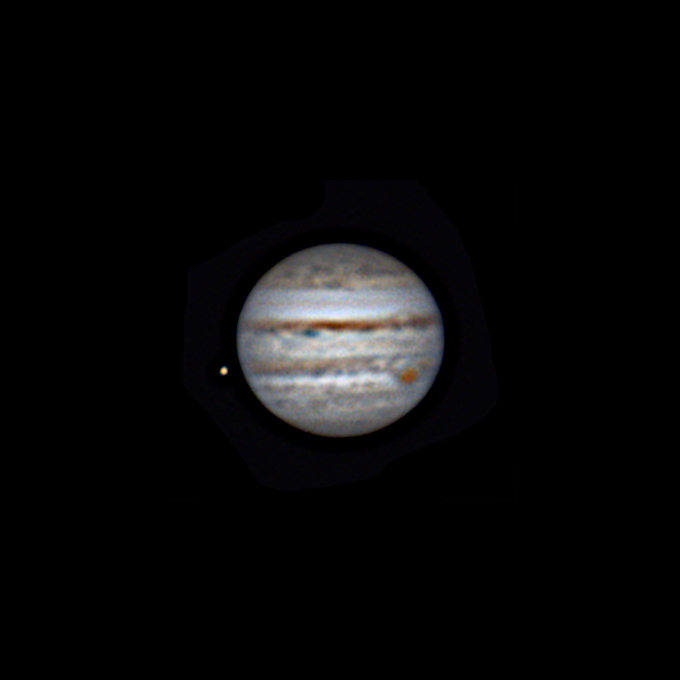
After the opposition, in the great hall of Jupiter, there was a dance of satellites. We first saw the great Ganymede emerge from the shadow of Jupiter, which, after opposition, is projected to the "left". At the same time, Europe was approaching to later begin its transit, this time pursued by her own shadow. And finishing the transit and in perfect coordination, we saw Io approach to just hide behind the gas giant when Europe finished its transit. Incredible! It was a wonderful night (October 1-2). Without excessive humidity. Without clouds. No wind. Visibility was somewhat variable, but extraordinarily good as Jupiter remained high. Nights like this, here, there are three or four a year. So let's see a video made up of 87 images. Today the computer fumed...
Mini video showing the appearance of Ganymede when leaving the shadow cast by Jupiter. The Sun, after opposition, is to the "right", so the giant's shadow is projected to the "left". The apparition occurred at 10:53 p.m. on October 1.
Las imágenes con mayor resolución que pude obtener del tránsito de Europa sobre Júpiter. Sin duda mi pequeño Maksutov de 127mm estuvo dando lo mejor de si mismo. Noche del 1 al 2 de octubre.

After the supernight of October 1-2, something like this was to be expected. A super cake from Jupiter to the transit of Europe, made with love and using only the best ingredients. With 12 servings, more than ever! Enjoy them in health and in good company.
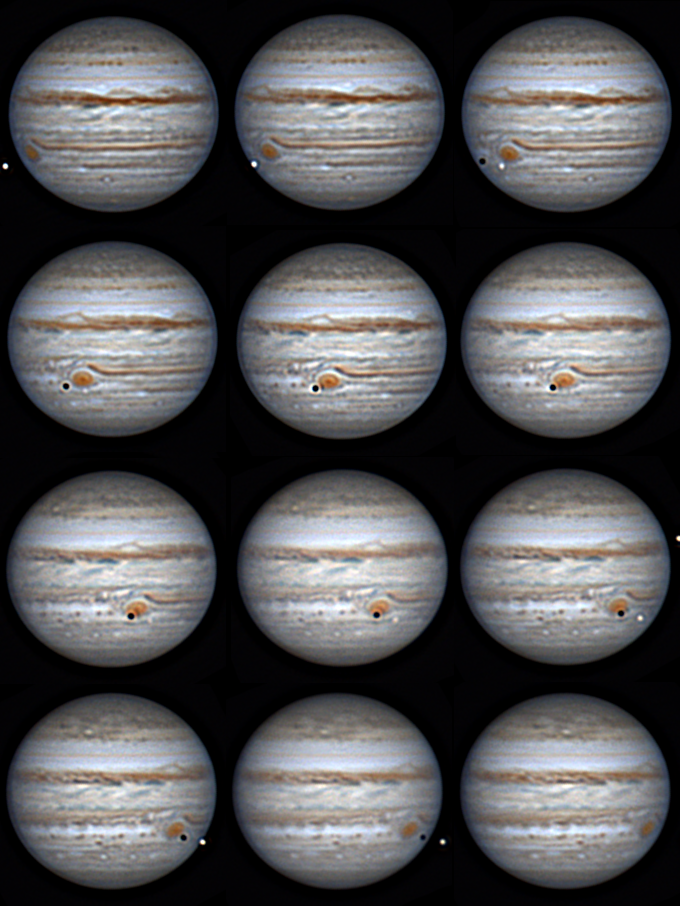
Jupiter in 3D. Would you like to see Jupiter as if you were traveling in a spaceship? Our eyes are about 63mm / 2.48" apart on average. If we look at an object 70cm / 27.5" away with both eyes, the eyes and the object form a triangle with an opening of about 5 degrees (opening of the vertex in the object). Jupiter takes 8 minutes to rotate 5 degrees. The time separation in the images is, from top to bottom, 4, 8, 11 and 15 minutes. If we CROSS OUR EYES in the image below and superimpose them, we will see Jupiter in three dimensions. But I wanted to test if 8 minutes is the optimal time. If when I cross my eyes I overlap the first pair, I see Jupiter in 3D, but a little flat. In the second pair, indeed, I see spherical Jupiter. In the third, I see it a bit like a rugby ball, and even more so in the fourth. It is probable that you will not see the same as me, because the distance at which you look at the images is less or greater. So the big question is, when do you see Jupiter best? In the first pair, in the second, in the third, or in the fourth?
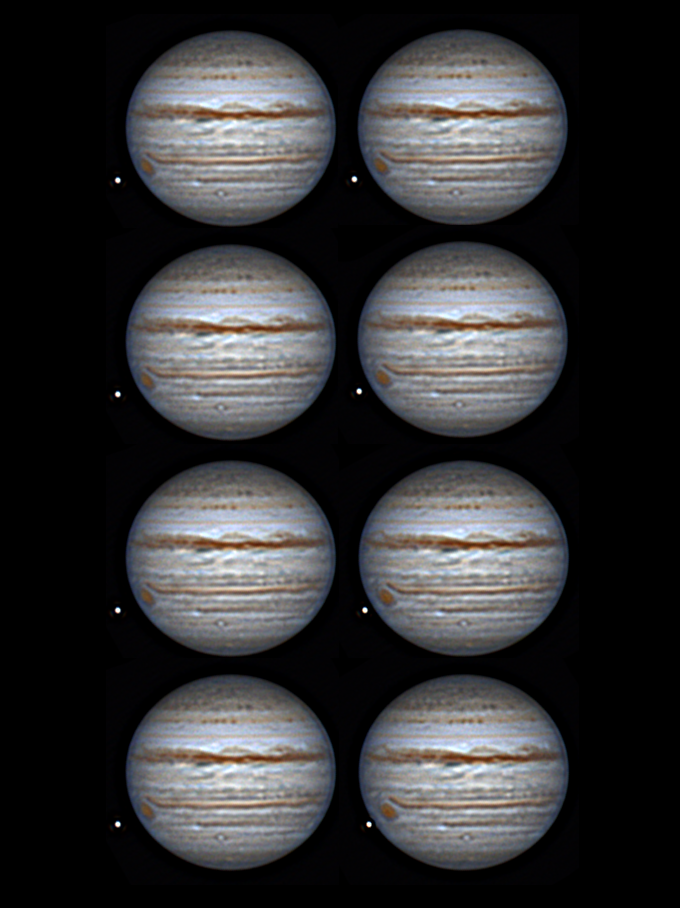
Jupiter the night of October 12 to 13. Three hours of observation summarized in a video. It starts at 22:31 and ends at 01:35. After midnight the visibility began to worsen due to the appearance of mist and I finally gave up. They are the last images of my little Mak. I've sold it and it's already on its way to a new life.
The best image of Jupiter from the night session of October 12-13.
